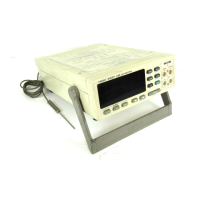.3.3 Headers
NOTE
The command name of the 3227 uses the easy understanding words for the
functions, and is able to shorten. The command name is called "longform" and
the shortened one called "shortform". The response messages from the 3227
are returned with the capital long form.
In this instruction manual, the short form is written with the capital letter,
and the rest is written with the small letter, however, this unit accepts them
whichever letters are used.
MEAsure OK (long form)
MEAS OK (short form)
MEASU error
MEA error
The program messages always needs the header.
For the response messages, the header is able to select with ":HEADer"
command. When turning on the power, the header puts on the response
messages.
The header does not put on the response messages for the common command
query, regardless of the setting state of ":HEADer" command.
(1) Command program headers
There are three types of commands: simple commands, compound commands,
and common commands.
Simple command header
This header is a sequence of letters and digits.
Example :HEADer
Compound command header
This header is made up from a plurality of simple commands type headers
marked off by colons.
Example :RESIstance:RANGe
Common command header
This header starts with an asterisk and continues with a common command
stipulated by IEEE 488.2.
Example *RST

